Ki Sisa 2017: The Shining & Moishe’s Horns
by devadmin | March 16, 2017 8:32 pm
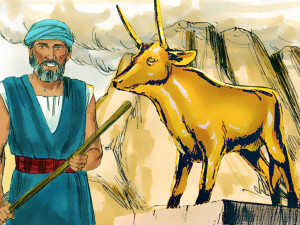 Mazel tov to Aliza & Yitzy Fuld upon the birth of a baby daughter, keyn yirbu and what else is new in the Gottesman family!? And welcome to the world Rochel Shoshana (Raquel Rose). May you bring much joy -for at least 120 years- to your parents, grandparents and our good friends Judith & Shlomo Gottesman and to Chayah & Yoel Fuld. As well to your great grandparents Rabbi & Mrs. Moshe & Sondra Gottesman and and to Judith’s amazing mom, Mrs. Blanche Lerer. Mazel tov to the extended Fuld & Gottesman families.
Mazel tov to Aliza & Yitzy Fuld upon the birth of a baby daughter, keyn yirbu and what else is new in the Gottesman family!? And welcome to the world Rochel Shoshana (Raquel Rose). May you bring much joy -for at least 120 years- to your parents, grandparents and our good friends Judith & Shlomo Gottesman and to Chayah & Yoel Fuld. As well to your great grandparents Rabbi & Mrs. Moshe & Sondra Gottesman and and to Judith’s amazing mom, Mrs. Blanche Lerer. Mazel tov to the extended Fuld & Gottesman families.
Raboyseyee and Ladies:
The Shining & Moishe’s Horns
Earlier this week, while perusing a 1970 book titled The Horned Moses in Medieval Art and Thought by Ruth Mellinkoff which the Oisvorfer came across a very interesting statement made by the author who writes azoy: it’s due to a “mistranslation” that led to the depiction of Jews as being horned and as being compared to the Devil himself. Ober, from whence was this mistranslation taken? How did it all begin and was Rashi somehow involved? Moishe had horns? Has the Oisvorfer gone mad? Nu, answers to these two questions are not necessarily mutually exclusive as we shall find out below.
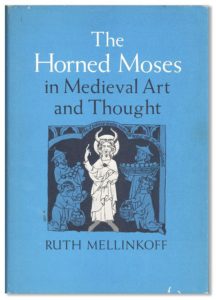 Some fifty years back the future Oisvorfer attended the wedding of a first cousin; it was the first wedding he was ever at. The chosson (groom), during what we call the ‘badekin ceremony,’ was danced up to the kallah (bride) where he carefully placed a veil over her face. She couldn’t see a thing. Many believe this minhag (custom) hearkens back to Yaakov Oveenu who had made arrangements with Lovon for the hand of his beautiful daughter Rochel in marriage, but woke up in the morning and astonishingly found Leah in his bed! Says the heylige Toirah (Bereishis 29:25) “And it was in the morning, and behold, it was Leah.” OMG! Can you just imagine marrying one sister only to wake up to find another in your bed? (Some say Rochel was under the bed, but that for another day.) Taka a fantasy some of you may have had, chazerim that you are, ober hopefully not on your wedding night.
Some fifty years back the future Oisvorfer attended the wedding of a first cousin; it was the first wedding he was ever at. The chosson (groom), during what we call the ‘badekin ceremony,’ was danced up to the kallah (bride) where he carefully placed a veil over her face. She couldn’t see a thing. Many believe this minhag (custom) hearkens back to Yaakov Oveenu who had made arrangements with Lovon for the hand of his beautiful daughter Rochel in marriage, but woke up in the morning and astonishingly found Leah in his bed! Says the heylige Toirah (Bereishis 29:25) “And it was in the morning, and behold, it was Leah.” OMG! Can you just imagine marrying one sister only to wake up to find another in your bed? (Some say Rochel was under the bed, but that for another day.) Taka a fantasy some of you may have had, chazerim that you are, ober hopefully not on your wedding night.
And strange as that sounds, our rabbis instituted that at Jewish weddings, the bridegroom is to cover the face of his intended bride. And that’s how it’s done ad hayoim hazeh (until today). Ober, if Yaakov was fooled, wouldn’t others be? And if the minhag taka does date back to Yaakov, does it make sense, ver veyst? Given what happened to him, and unless that’s taka what a person hopes for, shouldn’t the chosson make sure that his bride’s face remains uncovered in order to ensure that he brings home the right girl? Moreover, if the bride’s face is fully veiled through the use of an opaque veil thereby ensuring that the bride cannot see or be seen -as is the custom by chasiddim and other ultra orthodox by- how is the chosson to know whom he is marrying? Is it pot luck? Nu, some say that the veil is but symbolic and is meant to show that the groom is marrying the bride not just for her looks; meaning to say ‘I can cover your face with this veil and marry you because your face is but one level of your beauty.’ Of course (not)! It’s her inner beauty he desires. Of course! Certainly he desires her inners, if you chap. As an aside, one parsha (Bereishis 24:65) earlier we learned that Rivka, at the mature age of three, upon laying eyes on her bashert Yitzchok, covered her face with a veil. “She then took her veil and covered herself.” Why? Ver veyst? Some say the veil is the mark of modesty.
 Nu, guess what? Many rabbis now tell us that the covering of the face with a veil minhag is not at all related to Yaakov and his sister surprise; neither to Rivka. Instead, it’s related to another Toirah myseh, one found in the last few pisukim of this week’s amazing parsha. Welcome to Parshas Ki Sisa, arguably most famous for the cheyt ho’eygel (sin of the golden calf) where the Yiddin, a mere forty days past Revelation on Har Seenai, mamish a time of spiritual enlightenment, but after a gross time miscalculation, went about building a golden calf. Several thousand also worshiped it. Ah shandah (disgrace) mamish! The gantze myseh eygel and its aftermath are vividly described in the parsha. We have previously covered these events and if you want the Oisvorfer’s perspective on what went down and why, check out the archives at www.oisvorfer.com. Ober in this, our eighth review of Ki Sisa, we shall begin and mistama also end, with a discussion on a few very illuminating pisukim found at the very end of the parsha. Let’s begin by quoting them verbatim. Why begin with the last seven pisukim? Because it’s likely the case that most of you never paid much attention to them.
Nu, guess what? Many rabbis now tell us that the covering of the face with a veil minhag is not at all related to Yaakov and his sister surprise; neither to Rivka. Instead, it’s related to another Toirah myseh, one found in the last few pisukim of this week’s amazing parsha. Welcome to Parshas Ki Sisa, arguably most famous for the cheyt ho’eygel (sin of the golden calf) where the Yiddin, a mere forty days past Revelation on Har Seenai, mamish a time of spiritual enlightenment, but after a gross time miscalculation, went about building a golden calf. Several thousand also worshiped it. Ah shandah (disgrace) mamish! The gantze myseh eygel and its aftermath are vividly described in the parsha. We have previously covered these events and if you want the Oisvorfer’s perspective on what went down and why, check out the archives at www.oisvorfer.com. Ober in this, our eighth review of Ki Sisa, we shall begin and mistama also end, with a discussion on a few very illuminating pisukim found at the very end of the parsha. Let’s begin by quoting them verbatim. Why begin with the last seven pisukim? Because it’s likely the case that most of you never paid much attention to them.
Says the heylige Toirah (Shemois 34:29-35), azoy: “Moishe descended Har Seenai, holding the two tablets of the Testimony when he came down from the mountain; and Moishe was unaware that the skin of his face was radiant since God had spoken to him. Aharoin and all the people saw the skin of Moishe’s face was radiant and they shrank from approaching him. But Moishe called to them, and Aharoin and the leaders of the community retuned to him, and he spoke to them. Afterwards all the children of Israel approached him and he instructed them concerning all the Lord had spoken on Har Seenai. And when Moishe finished speaking with them, he put a veil over his face. Whenever Moishe came before the Lord to speak with Him, he would remove the veil until he came out. He would come out and tell the children of Israel that which he had been instructed. The children of Israel saw Moishe’s face, that the skin of his face was shining, and Moishe would then put the veil back on his face until he went in to speak with Him.” The Hebrew word the heylige Toirah uses in posik 29 to describe Moishe’s illumination is ‘ko-ran’.
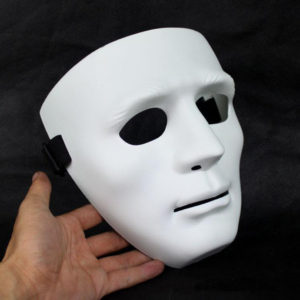 In other words: After smashing the first set of Luchis (The tablets containing the Ten Commandments) and after ascending and then descending for a second time, Moishe’s face was now glowing with some sort of celestial light that shone with great intensity. As a result, he was thereafter, and at certain times, forced to don a mask. Ober, what is real pshat in these pisukim? Was Moishe’s face mamish aglow? To a point where the Yiddin were frightened to approach him? And to a degree where he was forced to wear a mask so that his people, the Yiddin, could look at him? Did he become hideous looking? Was Moishe suffering from the aftereffects of a severe sunburn while atop the mountain for forty days? Grada this pshat seems plausible as it would still be thousands of years before Coppertone and others came to market with farshidina (various) sun screens that effectively block out UVA and UVB rays. Ober, as you can only imagine, many looked at these pisukim with some bewilderment: how was it taka the case that Moishe’s face was now glowing? Why didn’t it glow following his first forty-day trip to the mountain top? Why, only after his second trip? The Yiddin took one look at him and were forced to turn away? Moreover, why was Moishe’s face biclall radiating and glowing? At what times specifically did Moishe wear his veil? Was Moishe channeling the future holiday of Purim which would only come about hundreds of years later? The bottom line: we don’t know! And we don’t know because the heylige Toirah tells us nothing more than what’s quoted above. Seemingly the RBSO wanted our exegetes, beginning with Rashi, to pontificate over this matter. And they did! Let’s see what a few had to say about Moishe’s face.
In other words: After smashing the first set of Luchis (The tablets containing the Ten Commandments) and after ascending and then descending for a second time, Moishe’s face was now glowing with some sort of celestial light that shone with great intensity. As a result, he was thereafter, and at certain times, forced to don a mask. Ober, what is real pshat in these pisukim? Was Moishe’s face mamish aglow? To a point where the Yiddin were frightened to approach him? And to a degree where he was forced to wear a mask so that his people, the Yiddin, could look at him? Did he become hideous looking? Was Moishe suffering from the aftereffects of a severe sunburn while atop the mountain for forty days? Grada this pshat seems plausible as it would still be thousands of years before Coppertone and others came to market with farshidina (various) sun screens that effectively block out UVA and UVB rays. Ober, as you can only imagine, many looked at these pisukim with some bewilderment: how was it taka the case that Moishe’s face was now glowing? Why didn’t it glow following his first forty-day trip to the mountain top? Why, only after his second trip? The Yiddin took one look at him and were forced to turn away? Moreover, why was Moishe’s face biclall radiating and glowing? At what times specifically did Moishe wear his veil? Was Moishe channeling the future holiday of Purim which would only come about hundreds of years later? The bottom line: we don’t know! And we don’t know because the heylige Toirah tells us nothing more than what’s quoted above. Seemingly the RBSO wanted our exegetes, beginning with Rashi, to pontificate over this matter. And they did! Let’s see what a few had to say about Moishe’s face.
Says the heylige Gemora: Moishe’s radiance was a manifestation of the Divine Presence which had transformed Moishe’s essence. He was epes a new man; seemingly an enlightened one. Looking at Moishe was like looking at the sun. And whereas every Jew is born with what we proverbially refer to as ‘the pintile yid,’ or, the pilot light, it appears to the Gemora that Moishe’s pilot ignited to a point where his face was permanently radiant.
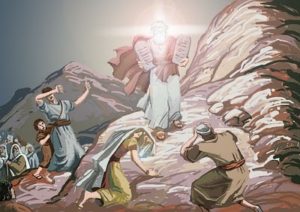 Says the medrish (Shemois Rabbah 47), Rebbe Yehudah ben Nachman stated in the name of Reish Lokesh, azoy: the radiance on his face came from a drop of ink. From ink? Yes! Moishe was up on the mountain taking dictation, reducing the RBSO’s words to writing, and when done, shoin, there was still a droplet of ink left over. What to do? The RBSO Himself smeared it on his forehead; Moishe was now radiant. This drop of holy ink was the source of Moishe’s ‘ray of splendor.’ In other words: the RBSO gifted Moishe with a drop of ink. Why? Ver veyst? Ober shtelt zich di shaylo azoy: if the RBSO prepared the holy ink for the heylige Toirah, we have to assume and we would be correct, that He prepared the exact amount needed. It’s not shayich (remotely possible) that the RBSO prepared too much ink, even one drop more than necessary. That being the case, how can the medrish suggest that Moishe’s face was now aglow as a result of the extra ink the RBSO Himself prepared and then smeared on his forehead? Taka a good kasha!
Says the medrish (Shemois Rabbah 47), Rebbe Yehudah ben Nachman stated in the name of Reish Lokesh, azoy: the radiance on his face came from a drop of ink. From ink? Yes! Moishe was up on the mountain taking dictation, reducing the RBSO’s words to writing, and when done, shoin, there was still a droplet of ink left over. What to do? The RBSO Himself smeared it on his forehead; Moishe was now radiant. This drop of holy ink was the source of Moishe’s ‘ray of splendor.’ In other words: the RBSO gifted Moishe with a drop of ink. Why? Ver veyst? Ober shtelt zich di shaylo azoy: if the RBSO prepared the holy ink for the heylige Toirah, we have to assume and we would be correct, that He prepared the exact amount needed. It’s not shayich (remotely possible) that the RBSO prepared too much ink, even one drop more than necessary. That being the case, how can the medrish suggest that Moishe’s face was now aglow as a result of the extra ink the RBSO Himself prepared and then smeared on his forehead? Taka a good kasha!
Ober not to worry: the Oir Hachaim (34:29) mamish so gishmak, tells us azoy: The RBSO taka prepared just the right amount of ink for Moishe to record the heylige Toirah. What went wrong? Human intervention. When the RBSO instructed Moishe to write the words we find in Bamidbar (12:3) “and the man Moishe was exceedingly humble, more than any person on the face of the earth,” Moishe refused to write them as instructed. He refused to write that about himself. When it came to writing the Hebrew word for humble, “Onov” which is typically spelled with the letter ‘yud’, Moishe left out the Yud. The word was seemingly misspelled. Shoin, that little droplet, not used, was now left over and wound up on his forehead. And listen to this connect-the-dots pshat given by none other than the Apta Ruv (AKA: the Oihave Yisroel) who said azoy: Later on in Bamidbar (27:20) when Moishe gets the bad news that his visa into the Promised Land is to be cancelled and that he needs to appoint Yihoishua (Joshua) as his successor, he will be specifically be commanded azoy: “And you shall put from your own splendor upon him.” What’s pshat splendor? Where was Moishe to get splendor to put some on Yihoishua? And how does one go about putting splendor on another person? Said the Apter azoy: Moishe’s splendor was his radiance, he was still aglow from his trip to the mountain top kimat forty years back. We can now kler azoy: efsher while embracing Yihoishua and giving him a man-hug upon his ascension to leadership, they embraced one another and also bumped heads. With the head bump, some glow rubbed off Moishe’s face and onto Yihoishua’s. Yihoishua was now also a shining example of Jewish leadership. Gishmak!
 Ober does everyone agree that Moishe’s face was aglow from a droplet of oil? Let’s reread posik 29. “It was when Moishe came down from Har Seenai, and the two tablets of the Testimony were in Moishe’s hand when he came down from the mountain, that Moishe did not realize that the skin of his face was beaming (from the Eternal’s) speaking with him.” Does everyone agree that the Hebrew word ‘ko-ran’ used above to describe Moishe’s appearance, meant that he was glowing? Seemingly not! Says Rashi azoy: the word Ko-ran is a term connected to karnayim, meaning “horns.” Moishe suddenly grew and had horns? Who knew? Moishe did what? Was Michelangelo then correct when depicting our man Moishe with horns? Can this be pshat? Does Rashi really mean to tell us that Moishe descended from Har Seenai sporting a pair of horns? Perhaps.
Ober does everyone agree that Moishe’s face was aglow from a droplet of oil? Let’s reread posik 29. “It was when Moishe came down from Har Seenai, and the two tablets of the Testimony were in Moishe’s hand when he came down from the mountain, that Moishe did not realize that the skin of his face was beaming (from the Eternal’s) speaking with him.” Does everyone agree that the Hebrew word ‘ko-ran’ used above to describe Moishe’s appearance, meant that he was glowing? Seemingly not! Says Rashi azoy: the word Ko-ran is a term connected to karnayim, meaning “horns.” Moishe suddenly grew and had horns? Who knew? Moishe did what? Was Michelangelo then correct when depicting our man Moishe with horns? Can this be pshat? Does Rashi really mean to tell us that Moishe descended from Har Seenai sporting a pair of horns? Perhaps.
Moreover, the word ke’ren is found several times throughout Tanach (Scriptures) and in our daily davening and none of its meanings are associated with radiance of any sort. In fact, in one use as found in II Shmuel (Samuel), the expression “keren yishi” is taka meant to suggest “my horn of redemption.” Grada, those who daven daily cite the words “..matzmiach keren yishuah.” Again the word is not associated with radiance or a shiny face. There are numerous other examples, ober you get the point.
Said the Bechor Shor: the skin on Moishe’s face was beaming. His skin was shining from the aura of the Holy Presence. Meaning, when the light shone from his face and the pillar of light which formed opposite him, it resembled horns. And he says this why? Because the very same word -ke-ren- translates to the horns of an animal. The bottom line: Rashi and others had no problem associating the word ko-ran with horns. Early Christian translations of the heylige Toirah seemingly followed suit. The words ko-ran or ke-ren were associated with horns but not in a bad way. Sadly, some time later, the antisemitishe goyim used these very horns, which were meant to depict the splendor on Moishe’s face upon his return with the second set of Luchois, with the devil and his horns. The rest is history. The incalculable harm caused to the Yiddin by way of various pogroms as a result of mistranslation, is beyond the scope of this review.
And this wondrous phenomenon only occurred when Moishe received the second set of Tablets. Why davka only for the second set? Because this set was given privately without the fanfare, thunder, light, and smoke show which accompanied Revelation. It was to show the people that the second set were just as holy though given over to Moishe in a private ceremony. A glowing face or horns would certainly get their attention. Ober says the Rashbam (Rashi’s own grandson), azoy: the word ke-ren refers to splendor and anyone who compares the word ke-ren as found in our posik above, and translates it to mean ‘”horns” as the word ke-ren is used later in the heylige Toirah, is mistaken. Shoin. Ober, are horns bad? Is describing Moishe’s appearance as being horn-like giferlich? Says the Riva, quoting Rashi, that the word “ko-ran” derives from the word ‘ke-ren’ (a horn). He goes on to say that the ke-ren of Moishe’s face was a bright light that protruded from Moishe’s head in the form of a horn.
The bottom line comes from yet another medrish. Whether Moishe’s change in countenance was a result of a droplet of ink smeared on by the RBSO, or, whether a light was shining through some horn, ver veyst. Moishe’s face had a shine before he came down with the second set of Luchis. His face was already illuminated after his first trip. At that time however, the Yiddin were able to look at him and were not frightened. Why not? Because they too, following Revelation were on a high spiritual plane, the very plane he was one. He looked as did they. Ober once, as described in our parsha, they miscalculated and thought him dead (the Soton, that minuvil, showed them an image of Moishe’s dead body floating) and after they built and reveled around and with the eygel, they lost their shine. Their light extinguished, they no longer saw Moishe as they saw themselves. They were suddenly sensitive to the unfiltered light Moishe’s exalted face was giving off. Gishmak.
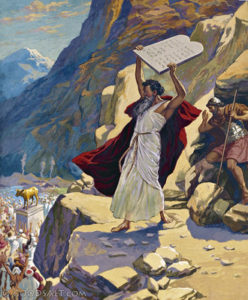 Moishe broke the first Luchois (the Tablets)? Who gave him permission to break the RBSO’s handiwork and holy words? Isn’t it forbidden to throw out anything with the RBSO’s name? Isn’t that what we call ‘sheymois’ which need to be discarded through burial? Who gave Moishe permission to deliberately destroy the RBSO’s holy Luchois Habris?
Moishe broke the first Luchois (the Tablets)? Who gave him permission to break the RBSO’s handiwork and holy words? Isn’t it forbidden to throw out anything with the RBSO’s name? Isn’t that what we call ‘sheymois’ which need to be discarded through burial? Who gave Moishe permission to deliberately destroy the RBSO’s holy Luchois Habris?
Nu, answers the Kesef Mishna so gishmak azoy: the prohibition of destroying written objects which contain the name of the RBSO is only Mi’di’rabonon. In other words: it’s rabbinical in nature only. When Moishe, upon encountering the eygel party, efsher also accompanied by a shtikel orgy according to some, lost his temper and broke the Luchois, this and many other rabbinic chumras (enactments) had yet to have been promulgated. Moreover, let’s not forget what our rebbes, quoting chazal of course (the Rokeach and the Rogotchover Goan) tell us: just before Moishe broke the Luchois, the written words, the holy letters, miraculously flew away and back to shomayim (heaven). Moishe was then left holding two stones that were no longer holy. As a result, he did nothing wrong by shattering them. Holding onto heavy stones, if you chap, can taka be tiring. Want more? As soon as the letters flew away, the stones lost their kidusha (holiness) and as a result they became heavy in his hands. Until they were sort of carrying themselves. Once they became heavy in his hands he just threw them down. Ober says the Oir Hachaim quoting a medrish (Avos D’Rav Nosson): Moishe only broke the Luchois after the RBSO explicitly commanded him to so. The bottom line: we got new ones. Slightly different but brand new.
Shoin, we all agree that Moishe’s face had a shine. We don’t know with certainty if the shine came about from his horns, leftover ink, or through some other natural or unnatural source. And we all agree, as does the heylige Toirah specifically tell us, that he wore a veil or mask. Ober when in fact did Moishe wear it? Nu, that answer too depends on which medrish talks to you. Says the Ha’emek Devar, azoy: Moishe kept his face veiled at all times. Or, at least whenever he interacted with the people. And his proof? The very last posik in our parsha which tells us azoy: “Moishe would then put the veil back on his face until he went to speak to Him.” In other words: he kept his face covered at all times until he went off to speak with the RBSO. Ober, if that’s the case, shtelt zich noch a shaylo (another question arises): If in fact the RBSO wanted Moishe’s face to shine, and seemingly shine it did, be it from ink, or through his horns, what good purpose did the shine serve, if Moishe was forced to keep his face covered? If the Yiddin were to be inspired by his countenance, how was this to be accomplished with a covered face?
Moreover, pisukim earlier the heylige Toirah seems to tell us a different story. The posik there seems to tell us that Moishe veiled himself only after he had finished speaking to the people. He spoke to them unmasked. Which was it? Masked or unmasked? Masked part time or full time? Nu, let’s ask the medrish; it always offers a new potential pshat. Efsher the glow on Moishe’s face came from the heylige Toirah itself. Moishe was not in a constant state of permanent glow. It was the heylige Toirah he had just taken in from the RBSO which gave off a shine which was now reflected on his face. Moishe had become part of the Toirah itself. And taka says the Ibn Ezra so gishmak, azoy: Moishe’s radiance was recharged every time he received a new mitzvah from the RBSO. The brilliance was a mere reflection of the light of the heylige Toirah. So long as Moishe was up there receiving the Toirah and all its contents (the oral traditions as well), his face radiated. With each mitzvah taught, his face further illuminated. Ober at some time after the Yiddin finally left Har Seenai and surrounds, with Toirah already in hand, this supernatural phenomenon may have stopped. Ober, why would the medrish suggest that Moishe’s face may have lost its shine over time? Efsher because we never hear about this mask again? Plausible? Why not?
Nu, since we opened with, and discussed at length, the last few pisukim of the parsha, we close with a thought on the very beginning of Ki Sisa. And why not? Where is it written that the parsha needs to be reviewed in any set order. In fact, it’s in this week’s parsha, that Rashi -and who knew better- states (Shemois 30:16) with a degree of certitude, azoy: from this, meaning from the instructions the RBSO gave to count the Yiddin, we learn that Moishe was commanded to count them at the beginning of the contributions to be collected for the entire Mishkan project. In other words: At least the beginning of Ki Sisa and perhaps most of it, took place before parshas Teruma and Tetzaveh. It did?
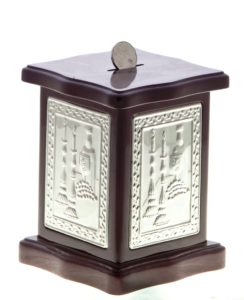 And why then does this parsha appear but after those two? Nu, another Rashi just last week stated azoy: eyn mukdom, umuchor baToirah (there is no chronological order to the heylige Toirah.) Accordingly, events described in our parsha, specifically the eygel fiasco, may or may not have taken place earlier, or later. What’s pshat may or may not? Nu, that depends on which medrish talks to you. Some argue that the eygel caper took place before the instructions on the building of the Mishkan as described in the last two parshas, while others suggest that events in the heylige Toirah are assumed to be chronological unless they are not. Which was it? Ver veyst? Veyter.
And why then does this parsha appear but after those two? Nu, another Rashi just last week stated azoy: eyn mukdom, umuchor baToirah (there is no chronological order to the heylige Toirah.) Accordingly, events described in our parsha, specifically the eygel fiasco, may or may not have taken place earlier, or later. What’s pshat may or may not? Nu, that depends on which medrish talks to you. Some argue that the eygel caper took place before the instructions on the building of the Mishkan as described in the last two parshas, while others suggest that events in the heylige Toirah are assumed to be chronological unless they are not. Which was it? Ver veyst? Veyter.
One of the first songs the future Oisvorfer learned as a young child was ‘hoishio es amecho uvorache es nachlosecho, ureim, v’naseim ad ho’oilom’. Notice please that the song has but ten words. These ten words, he was told, were also to be invoked whenever Jews were to be counted. Ober why not count people with one, two, three, four, etc? Though counting by numbers has long been accepted by the AICPA and in other places where a tally must be given, for us Yiddin, counting (people) by numbers is strictly verboten. It is? Indeed so and taka that’s how this week’s parsha of Ki Sisa opens. In the very first posik, the RBSO instructs Moishe that henceforth, whenever a census is to be taken, Moishe is to have them counted by having each person hand over a half-shekel coin which was seemingly used as a personal redemption. Once collected, each coin, now representing one person, was to be counted. Personal redemptions they would sadly taka need as the parsha moves forward; did they ever. Nu, as you can only imagine, when it came to ponying up some coin, even a half- shekel, even for personal redemption, not every Yid wanted to be counted. We can kler that a few sat out the census, others mistama only contributed a quarter, and it’s mistama sadly also the case that one clever fellow came along, removed the coins, and replaced them with a check. Shoin! The bad news: in our times, we can no longer buy our way out of trouble. The good news: when it comes to counting money, or anything else besides people, we may continue to count by numbers.
A gittin Shabbis
Heylige Oisvorfer Ruv
Yitz Grossman
Source URL: https://oisvorfer.com/ki-sisa-2017-the-shining-moishes-horns/